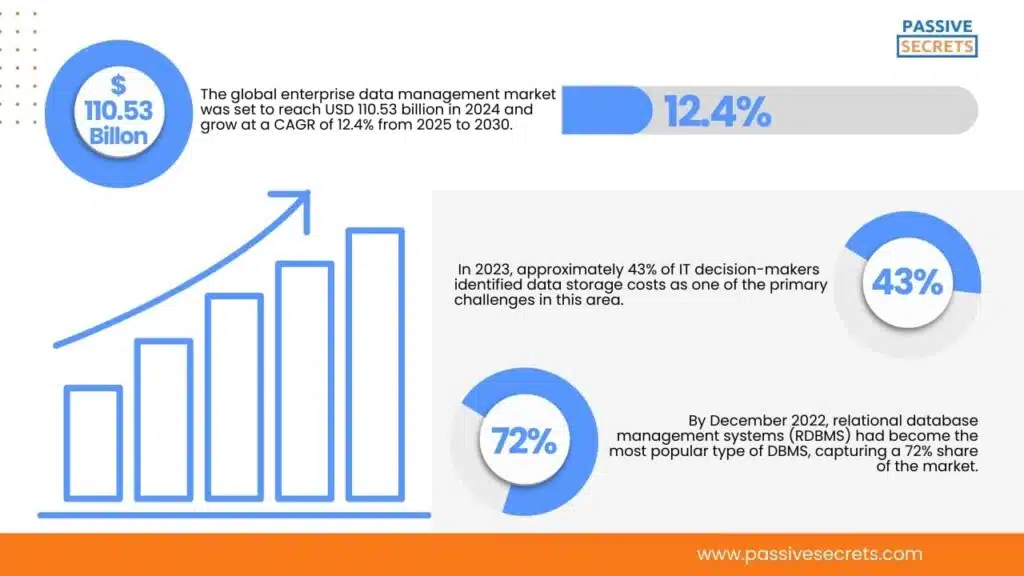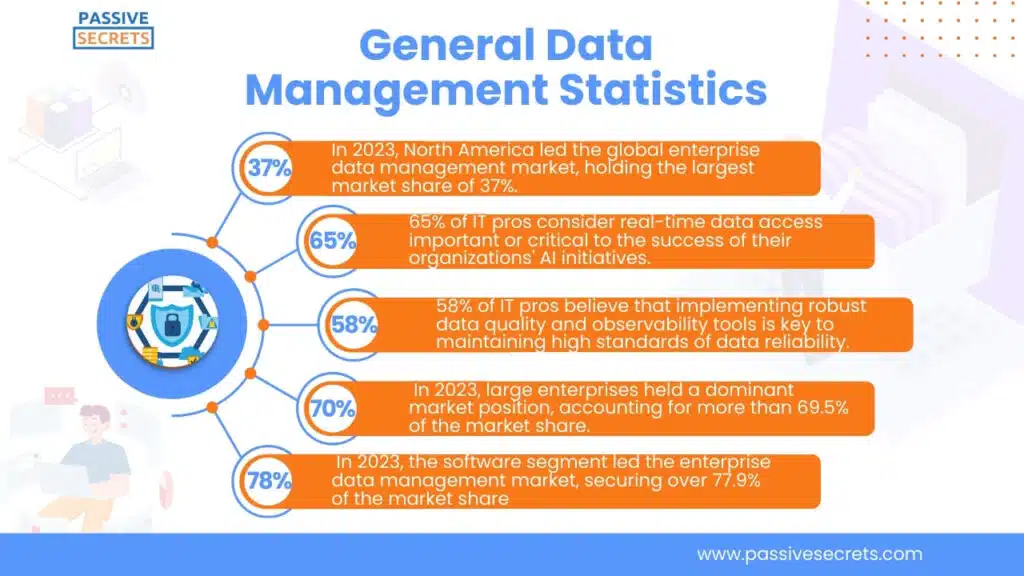
Did you know the world generates 328.77 million terabytes of data every day? Data is growing at an unprecedented rate, and how businesses manage this information can make or break their success.
From the intense rise of cloud storage to the increasing importance of data governance and AI-driven analytics, data management statistics and trends are reshaping industries across the globe.
If you’re trying to streamline operations, enhance decision-making, or ensure compliance, you should stay informed about the latest statistics and trends in data management.
In this article, we uncover the data management statistics and insights driving the future of data management, helping you stay ahead in the data-driven era.
General Data Management Statistics
1. The global enterprise data management market was set to reach USD 110.53 billion in 2024 and grow at a CAGR of 12.4% from 2025 to 2030. (source)
2. In 2023, approximately 43% of IT decision-makers identified data storage costs as one of the primary challenges in this area. (source)
3. By December 2022, relational database management systems (RDBMS) had become the most popular type of DBMS, capturing a 72% share of the market. (source)

4. As of June 2024, Oracle ranked as the most popular relational database management system (RDBMS) globally, with a score of 1244.08. (source)
5. Global data creation, capture, copying, and consumption are expected to grow rapidly, reaching 149 zettabytes in 2024. This figure is projected to surpass 394 zettabytes by 2028. However, only a small portion of the newly generated data is retained, with only 2% of the data produced and consumed in 2020 being saved and kept into 2021. (source)
6. The South Korean enterprise data management market is expected to grow at a compound annual growth rate (CAGR) of 6.20% from 2024 to 2032. (source)
7. 90% of IT professionals indicate that their data management practices are either somewhat or fully aligned with their AI innovation objectives. (source)
8. 65% of surveyed CTOs and IT professionals regard real-time data access as essential for AI success, citing it as either important or critical. (source)
9. 90% of IT professionals believe that improved data literacy would have at least a moderate impact on the success of AI projects, with 40% expecting it to have a significant impact. (source)
10. Nearly 87% of surveyed IT professionals express a strong desire to implement AI, with 47% showing “very strong” intent. Additionally, 86% report making significant (50%) or very significant (26%) progress in their AI initiatives. (source)
11. 90% of IT pros assess their organization’s data management practices as either somewhat or fully aligned with AI innovation goals. (source)
12. With 37% of data analysts and other IT pros reporting their data management efforts as “very aligned” with AI development, this suggests that around 6 in 10 of them feel their companies still have a long way to go before being fully prepared to leverage AI. (source)
13. 58% of IT pros believe that implementing robust data quality and observability tools is key to maintaining high standards of data reliability. (source)
14. 65% of IT pros consider real-time data access important or critical to the success of their organizations’ AI initiatives. (source)
15. IT professionals from a recent survey identified increasing awareness of data’s value (69%), fostering cross-functional collaboration (66%), and building a data-driven culture (61%) as key strategies. (source)
16. The global enterprise data management market was valued at over USD 99.40 billion in 2023 and is expected to rise from USD 111.44 billion in 2024 to around USD 349.52 billion by 2034, growing at a CAGR of 12.11% during the period. (source)
17. In 2023, North America led the global enterprise data management market, holding the largest market share of 37%. (source)
18. The U.S. enterprise data management market was valued at USD 25.74 billion in 2023 and is expected to reach approximately USD 92.40 billion by 2034, growing at a CAGR of 12.32% from 2024 to 2034. (source)
19. The Enterprise Data Management market is expected to reach approximately USD 281.9 billion by 2033, up from USD 97.5 billion in 2023, growing at a CAGR of 11.2% from 2024 to 2033. (source)
20. In 2023, large enterprises held a dominant market position, accounting for more than 69.5% of the market share. (source)
21. In 2023, the cloud-based segment dominated the enterprise data management market, capturing over 58.4% of the share due to its scalability and cost-effectiveness. (source)

22. In 2023, the software segment led the enterprise data management market, securing over 77.9% of the market share. (source)
23. 68% of data professionals take 4+ hours to detect data incidents, up from 62% in 2022. (source)
24. 50% of data professionals say data engineering is mainly responsible for data quality. (source)
Statistics About Challenges In Data Management
25. 50% of IT professionals encounter challenges in organizing unstructured data for retrieval-augmented generation (RAG). 52% have difficulty organizing structured data for machine learning. (source)
26. T primary obstacles to accessing high-quality data for AI projects are data privacy and security issues (28%) and data volume (25%). (source)
Latest Data Management Trends in 2025
1. Increasing Data Access and Improving Understanding
Many businesses are working to expand access to data and improve the understanding of it. This trend is driven by the need for better collaboration and decision-making as companies increasingly rely on data to guide their strategies.
Data is now packaged in a way that makes it easy to find and use, allowing more people within a company to access it without needing help from technical teams. This self-service approach helps everyone make informed decisions based on the data available.
Additionally, companies are focusing on centralizing data access by bringing together data from different sources. Businesses can also get a clearer picture of their operations and make better choices.
This helps improve data quality and ensures that everyone is working with the same information. As organizations adopt these practices, they are fostering a culture where more employees feel empowered to use data in their work.
This shift not only enhances understanding but also encourages innovation. Overall, expanding data access and understanding is becoming essential for businesses aiming to thrive in a data-driven world.
2. Flash storage is expected to overtake hard disk drives in popularity.
Flash storage is quickly becoming more popular than traditional hard disk drives (HDDs) for several simple reasons.
The number one advantage of it is that they are much faster. They can also access and process data in microseconds, while Hard disk drives take milliseconds.
This speed is important for tasks that need quick data retrieval, like running applications or loading files. Secondly, they are generally more reliable. They don’t have moving parts like Hard disk drives do, which means they are less likely to break if dropped or bumped. This makes them a good choice for laptops and other portable devices.
Finally, they make use of less power than hard disk drives. This means they can help extend the battery life of laptops and reduce energy bills in data centers.
As businesses look to improve their technology and handle more data, the trend is moving toward using all-flash storage systems. With the growing need for fast and efficient storage, flash storage is set to become the go-to option, possibly pushing hard disk drives out of the picture in the near future.
3. Ransomware Threats
Ransomware is becoming a serious problem for businesses, and the costs are getting higher. Ransomware is a type of software that hackers use to lock people out of their files until they pay money to get them back.
The total cost of ransomware attacks can be very high. Companies not only have to pay the ransom, but they also face extra costs from downtime, recovery efforts, and damage to their reputation.

Recovering from an attack can be very expensive when you add everything together. Ransomware attacks are happening more often, with many businesses reporting that they’ve been targeted.
This growing threat shows how important it is for companies to take steps to protect themselves from ransomware, as the risks and costs keep rising.
4. Implementing AI/ML Technologies to Mitigate Data Risks
Many businesses are starting to use artificial intelligence (AI) and machine learning (ML) to help manage data risks.
These technologies can analyze large amounts of data quickly and find patterns that humans might miss. This means companies can identify potential risks before they become serious problems.
Using AI and ML allows businesses to create better strategies for handling risks. For example, AI can help predict future risks by looking at historical data, which helps companies prepare in advance. It can also monitor data in real-time, alerting businesses to new threats as they arise, so they can respond quickly.
Another benefit is that AI can automate the risk assessment process, making it faster and more accurate. This helps organizations understand their risk levels better and allocate resources more effectively.
Overall, adopting AI and ML solutions is becoming essential for businesses that want to improve their risk management. By using these technologies, companies can be more proactive in preventing issues.
FAQs

Other Related Statistics You Should Know:
- 80+ Employee Benefit Statistics: Insights and Trends
- Most Important Wealth Management Statistics You Can’t Ignore
- 93 Talent Management Statistics to Help You
- Top Reputation Management Statistics and Trends to Improve Your Brand
- 36 Helpful Social Worker Burnout Statistics To Know
- 100 Business Process Outsourcing Statistics & Facts
- Top HR Outsourcing Statistics and Trends Every Business Must Know
- The Top Outsourcing Statistics You Shouldn’t Ignore
- 47+ Shocking 4-day Work Week Statistics To Know
- 105+ Supply Chain Statistics & Facts You Can’t Ignore
- 50+ Interesting Employer Branding Statistics And Trends
- Job Seekers Statistics: Unemployment Rates, Preferences, Challenges
- 95 Interesting Job Interview Statistics and Huge Trends To Know
- 60+ Helpful Change Management Statistics & Facts
- 65+ Employee Performance Management Statistics & Trends
- Workforce Management Statistics: Trends, Insights, & Opportunities
- 73 Revealing Workplace Distraction Statistics
- Workplace Romance Statistics: How Common Is Workplace Romance?
- 40+ Top Workplace Conflict Statistics You Should Know
- The State of Workplace Communication: Key Statistics and Trends
- 55 Workplace Collaboration & Teamwork Statistics

